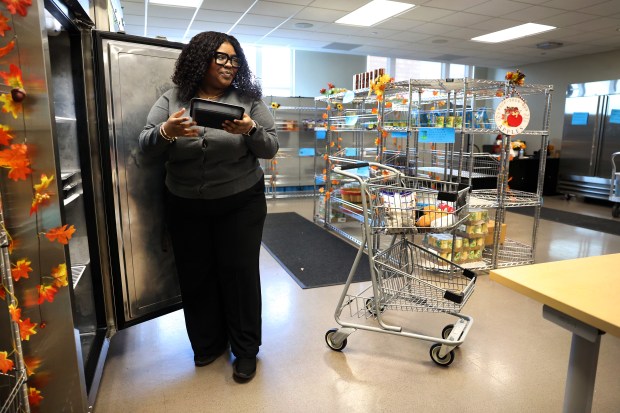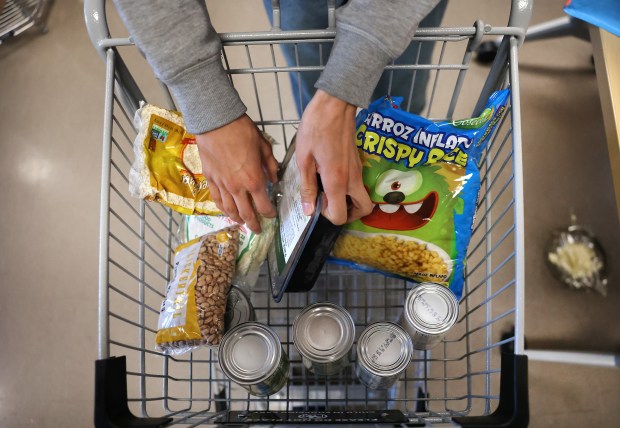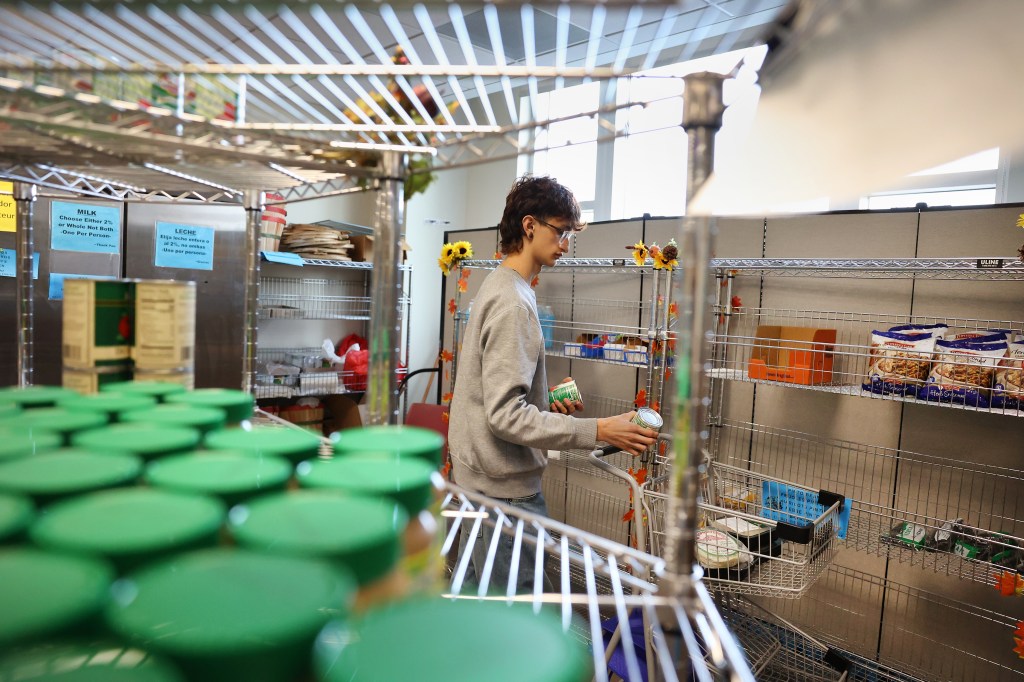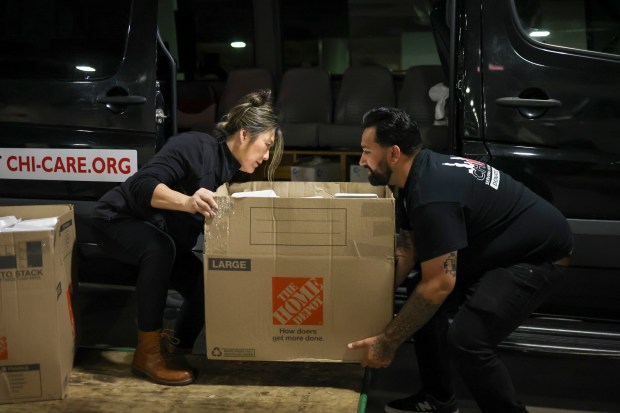As Supplemental Nutrition Assistance Program benefits run dry, some Chicago families have struggled to put food on the table — but communities, schools and businesses have risen to the challenge, stepping up in the face of uncertainty to help their neighbors.
Grocery stores and restaurants have distributed free food to those in need. Schools are organizing emergency food drives. And the city’s robust network of social services, nonprofits and churches have expanded their ongoing operations to meet increased demand from people at every stage of life.
“We cannot ignore the fact that we have a population that needs us,” said Roni Facen, principal of St. Francis de Sales High School, which is currently operating a bi-weekly food pantry.
Although it appears the federal government shutdown is nearing an end, it’s unclear when SNAP payments will be restored to the 1.9 million Illinois residents and 600,000 Chicagoans who receive them. A federal judge ordered the Trump administration to find money for the program at least through November, but that order was temporarily blocked by the U.S. Supreme Court on Tuesday. For now, the program remains on hold.
In North Lawndale, where 45% of residents receive food assistance, signage and word of mouth brought roughly 300 families to Fine Fair Food & Liquors, to receive free chicken, bread and drinks when SNAP funds weren’t disbursed at the beginning of the month, according to employee Denise Coleman. “We gave them something equivalent to a meal for a day, because some of these families might not have had dinner for that night,” Coleman said.
Coleman, a mother of six, utilizes SNAP. She said she tries to make sure to have a full freezer at all times to ward against times of uncertainty such as these.
Less than a mile away, Pastor Reshorna Fitzpatrick said more people are at the door of historic Stone Temple Missionary Baptist Church, as they are aware that SNAP might not snap back.
For this reason, the North Lawndale church has brought back “Soup for the Soul,” a program launched in response to the pandemic, which provides weekly hot meals and bag lunches to those in need.
Soup for the Soul operates on donated food – including fare from 23 neighborhood gardens and a 24-hour “Love Fridge,” where neighbors can donate and access fresh food and household supplies.
Normally, families shop and walk away with a bag of groceries, although Fitzpatrick said she’s been less strict about the number of bags recently because people are nervous. “I think they feel like they don’t know what to expect,” she said. “Even if SNAP does return, people are still going to feel like ‘If it happened, who knows what can happen next?’ I don’t think people know how to relax in the midst of turmoil.”
SNAP benefits first ran out on Nov. 1, a month into the government shutdown after Congress failed to pass a spending bill. It marked the first time in the program’s 60-year history that payments were not issued.
Schools step up
Students are also experiencing the squeeze of the SNAP cutoff.
St. Francis de Sales High School in East Side has been operating a student-run food distribution center monthly since the pandemic. However, in recent months, amid social service cuts, the Catholic school, in a neighborhood where 23% of residents are SNAP beneficiaries, has increased distribution to twice a week.
“I look at it, always, from the lens of kids,” said principal Facen. “These are babies.”
Ever since the shutdown, the demand for food has grown exponentially, Facen said. The school is only able to provide shelf stables to the first few hundred community members, many of whom line up hours in advance. A recent student survey found that a quarter of the student body are facing food insecurity. Roughly 45% of SNAP benefits go to households with kids statewide, according to the Illinois Department of Human Services.
“When we started to hear about SNAP, it was the kids that came forward asking, ‘What are we going to do?’” Facen said. “We had to do something.”
At City Colleges of Chicago, each of its seven main campuses offers a free market for students to pick up groceries and other necessities — a service that, for some, has become a lifeline amid the government shutdown.
 Kennedy-King College psychology student Mo’hogney Mitchell, 20, picks out food at the Healthy Student Market pantry on campus in Chicago’s Englewood neighborhood, Nov. 6, 2025. (Chris Sweda/Chicago Tribune)
Kennedy-King College psychology student Mo’hogney Mitchell, 20, picks out food at the Healthy Student Market pantry on campus in Chicago’s Englewood neighborhood, Nov. 6, 2025. (Chris Sweda/Chicago Tribune)
On a recent afternoon, Mo’hogney Mitchell, 20, walked down the aisles of Kennedy-King College’s campus food pantry in Englewood. Many of the shelves were already picked through. “I usually get the milk, eggs, and the instant rice,” Mitchell said.
She stacked her cart high with frozen meals, sweet potatoes and other produce.
Mitchell, the college’s student body president, relies on SNAP benefits to put food on the table for her grandmother. When, on Nov. 1, she saw that no benefits had been loaded onto her Link card. Her heart sank.
“Right now, food in my house is barely there,” she said. “My grandma, she’s the type to make something out of nothing. But when you have nothing, like really nothing at all, it’s really hard.”
Mitchell is one of the hundreds of students who rely on the college’s Health Student Market. On food delivery day, the line for the pantry snakes down the halls, according to Destinee Miguest, the director of student basic needs and wellness. The need has only been exacerbated amid the government shutdown.
“It’s an uptick, for sure,” Miguest said. “Food insecurity with college students is real.”
City Colleges is actively fundraising and growing its partnership with the Greater Chicago Food Depository to provide increased services, including expanded food markets and improved access to public benefits — including guidance for students navigating cuts or restrictions to those services. Currently, students are able to visit Kennedy-King’s market weekly.
 Kennedy-King College student Oscar Rosales, 19, pulls items out of his cart while bagging his food at the Healthy Student Market pantry on campus in Chicago’s Englewood neighborhood, Nov. 6, 2025. (Chris Sweda/Chicago Tribune)
Kennedy-King College student Oscar Rosales, 19, pulls items out of his cart while bagging his food at the Healthy Student Market pantry on campus in Chicago’s Englewood neighborhood, Nov. 6, 2025. (Chris Sweda/Chicago Tribune)
Jiwon McCartney, CEO of the nonprofit Fight2Feed, which rescues food from restaurants/food distributors to provide meals to organizations and food pantry bags to people in need, says she thought the pandemic was the tipping point when it came to food insecurity, but that has since changed with SNAP.
“I don’t know how to explain it. The numbers are increasing, it looks different than the pandemic,” she said. The 12-year-old nonprofit is doing its best to meet people where they are. Her organization initially projected fixing and disbursing 3,000 meals for Thanksgiving, but now that number has increased to over 4,300 – up 47% from 2024.
That’s because today’s food crisis is “hitting a different arena,” according to McCartney. “The people who are suffering now are those who have a job, but it’s not enough or (they) lost a job and it’s not enough; those who want to have a normal life, but can’t because they don’t have the funds or means to do it,” she said. And that includes people in Cook, Kane, McHenry and Lake Counties. When Fight2Feed began in 2014, the areas with the greatest need were in the city–Uptown and the South Side–according to McCartney. But she’s seen food insecurity extend to counties that surround Cook at a rate that is astounding.
Show Caption
1 of 4
Fight2Feed founder Jiwon McCartney pulls a tray of pulled pork out of the oven while volunteers pack meals in the East Kitchen in McCormick Place on, Nov. 5, 2025. They packed a total of 550 meals for multiple community partners. (Eileen T. Meslar/Chicago Tribune)
One of Chicago’s most at-risk populations is the elderly and the disabled, for whom getting to a food pantry can be difficult.
There are 300,000 more seniors who need home meal delivery every year–and that’s not factoring in the government shutdown or SNAP suspensions, according to Elise Geiger, executive director of Meals on Wheels Chicago
The organization delivers meals to people with disabilities aged 18 – 59 years old. At 60, senior meal delivery begins. Geiger attests that the clientele is increasing due to several factors, including inflation and longer life spans.
Their strategy is to prepare for the worst so they can cover as many people as possible and not change the frequency or cadence of their services because as Geiger says, “there’s no good scenario where there’s a waitlist to eat.”
And benefit delays aren’t only hurting those who rely on SNAP, but also the wider community looking to offer support, according to Hilary Seligman, a professor at the University of California, San Francisco, who specializes in food security and its health complications.
“The longer the delays in SNAP benefits go on, the more challenging it is for families to make ends meet,” Seligman said. “We can’t utilize the support of our friends and neighbors forever.”



